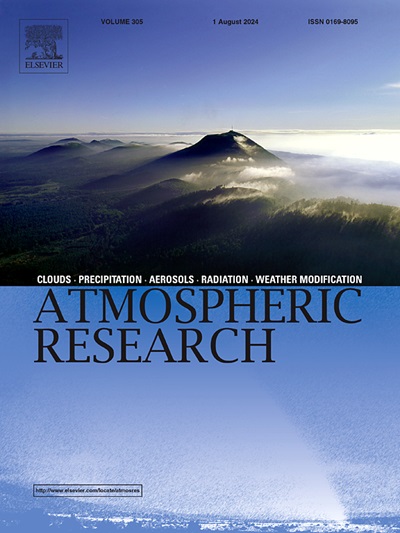Study on the characteristics of urban background ozone pollution based on long-term observations from mountain sites in China during 2015–2022
IF 4.5
2区 地球科学
Q1 METEOROLOGY & ATMOSPHERIC SCIENCES
引用次数: 0
Abstract
In recent years, Chinese cities have faced persistent O3 pollution challenges. O3 concentrations at urban mountain sites, serving as proxies for urban background O3 levels, can help address data gaps in O3 research in China. This study, for the first time, analyzed O3 data from ten urban mountain sites during 2015–2022 using statistical methods like the Mann-Kendall test, Theil-Sen slope estimation, and Pearson correlation analysis to reveal characteristics and trends in urban background O3 and proposed a metric for assessing mountain sites as urban background stations. Results indicate that O3 at mountain sites were generally higher than at plain sites, regardless of mean, 10th percentile, or 90th percentile the average maximum daily 8-h average (MDA8) O3. Although mountain sites exhibited similar annual and diurnal variations as plain sites, their amplitudes were significantly lower. Significant upward trends (P < 0.05) in MDA8 O3 were observed mainly at plain sites, whereas trends at mountain sites were insignificant (P > 0.05) during 2015–2022. The increase in urban ground-level O3 was largely due to changes in VOCs and NOx emission structures, which reduce nighttime titration effects while enhancing daytime O3 production. The insignificant trends observed at mountain sites suggest that these mountain sites may be in NOx-limited or transitional regimes rather than VOCs-limited regimes, which is also associated with their lower NOx concentrations compared to plain sites. These findings suggest that if China continues to prioritize the reduction of NOx emissions, urban ground-level O3 could further increase and approach the O3 at mountain sites. Finally, this study proposes that the correlation in nighttime O3 concentrations between mountain and plain stations can serve as a valuable indicator for evaluating the suitability of mountain stations as regional background stations in urban areas. It recommends mountain sites in cities such as Changji, Nanping for urban background O3 monitoring stations.
基于 2015-2022 年中国山区站点长期观测的城市背景臭氧污染特征研究
近年来,中国城市面临持续的臭氧污染挑战。城市山区站点的臭氧浓度作为城市背景臭氧浓度的代用指标,有助于解决中国臭氧研究中的数据缺口问题。本研究首次采用Mann-Kendall检验、Theil-Sen斜率估计和Pearson相关分析等统计方法,分析了2015-2022年10个城市山地站点的O3数据,揭示了城市背景O3的特征和变化趋势,并提出了山地站点作为城市背景站点的评估指标。结果表明,无论臭氧浓度的平均值、日最大 8 小时平均值(MDA8)的第 10 百分位数还是第 90 百分位数,山区站点的臭氧浓度普遍高于平原站点。虽然山区观测点的年变化和日变化与平原观测点相似,但其振幅明显较低。在 2015-2022 年期间,主要在平原地区观察到 MDA8 O3 的显著上升趋势(P < 0.05),而山区地区的趋势不明显(P > 0.05)。城市地面臭氧浓度的增加主要是由于挥发性有机化合物和氮氧化物排放结构的变化,这减少了夜间的滴定效应,同时增加了白天的臭氧产生量。在山区站点观察到的不明显趋势表明,这些山区站点可能处于氮氧化物受限或过渡状态,而不是 VOCs 受限状态,这也与山区站点的氮氧化物浓度低于平原站点有关。这些研究结果表明,如果中国继续优先减少氮氧化物的排放,城市地面的臭氧浓度可能会进一步增加,并接近山区站点的臭氧浓度。最后,本研究提出,山区站点与平原站点夜间臭氧浓度的相关性可作为评估山区站点是否适合作为城市地区区域背景站点的重要指标。研究建议将昌吉、南平等城市的山区站点作为城市臭氧背景监测站。
本文章由计算机程序翻译,如有差异,请以英文原文为准。
求助全文
约1分钟内获得全文
求助全文
来源期刊

Atmospheric Research
地学-气象与大气科学
CiteScore
9.40
自引率
10.90%
发文量
460
审稿时长
47 days
期刊介绍:
The journal publishes scientific papers (research papers, review articles, letters and notes) dealing with the part of the atmosphere where meteorological events occur. Attention is given to all processes extending from the earth surface to the tropopause, but special emphasis continues to be devoted to the physics of clouds, mesoscale meteorology and air pollution, i.e. atmospheric aerosols; microphysical processes; cloud dynamics and thermodynamics; numerical simulation, climatology, climate change and weather modification.
 求助内容:
求助内容: 应助结果提醒方式:
应助结果提醒方式:


